Hemifacial Spasm
The facial nerve (seventh cranial nerve) arises from the lower part of the pons in the brainstem, and travels through the fluid space adjacent to the brainstem called the basal cisterns. It then travels through a bony opening in the skull, the internal auditory canal, (long black arrow in image below) with the eighth cranial nerve and then travels to the face where its main motor nerve passes through the parotid gland as it divides into five branches that supply the muscles of the face.
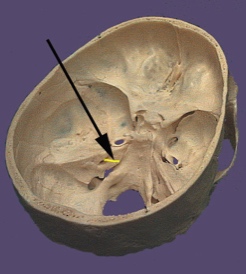
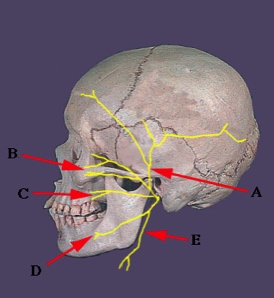
Branches of the facial nerve.
A. temporal, B. zygomatic, C. buccal,
D. mandibular, E. cervical
If the facial nerve is compressed in the basal cistern (the cerebello-pontine angle, CPA), then hemifacial spasm may develop.
This results in severe, intermittent twitching of the muscles of the face. It usually begins by involving the muscles around the eye, and can also involve the muscles around the mouth.
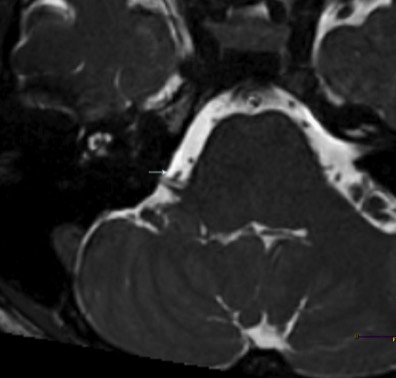
The most common cause of hemifacial spasm is compression of the nerve in the CPA by a loop of an artery. An artery that compresses the nerve as it leaves the pons at the root entry zone (REZ) causes the nerve insulation (myelin) to break down, and this results in excessive electrical firing of the nerve which causes the uncontrollable twitching of the muscles of the face.
Investigation of hemifacial spasm requires an MRI scan. The MRI scan is used to exclude the presence of a mass such as a tumour, and to identify any vascular compression of the facial nerve.
This image is from an MRI of the brain of a patient with Hemifacial Spasm. The small white arrow is pointing at a small vessel loop that is compressing the facial nerve in the CPA.
Investigation of hemifacial spasm requires an MRI scan. The MRI scan is used to exclude the presence of a mass such as a tumour, and to identify any vascular compression of the facial nerve.
This image is from an MRI of the brain of a patient with Hemifacial Spasm. The small white arrow is pointing at a small vessel loop that is compressing the facial nerve in the CPA.
Treatment of hemifacial spasm usually involves the injection of Botox into the affected muscles (performed by a neurologist trained in this procedure). This usually works quite well, and controls the symptoms in most patients. The Botox needs to be re-injected every few months. If Botox fails to control the symptoms, or there are intolerable side effects from Botox, then surgery is required.
Surgery for Hemifacial Spasm is known as Microvascular Decompression of the Facial Nerve. This involves opening inside the back of the head, microsurgically identifying the seventh and eighth nerves in the CP angle, and then separating the offending artery off the nerve. To keep the artery and nerve separated permanently, a piece of Teflon felt is placed between the two structures (see images below). This procedure is very similar to that used in the treatment of Trigeminal Neuralgia.
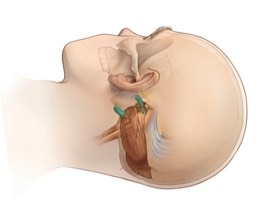
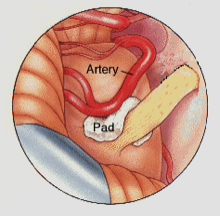
Obviously, there are always risks of any surgical procedure, and these should be discussed with Professor Davis before you proceed to operation.